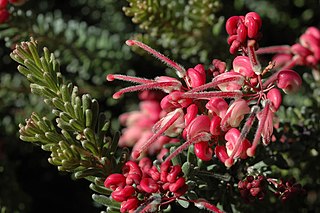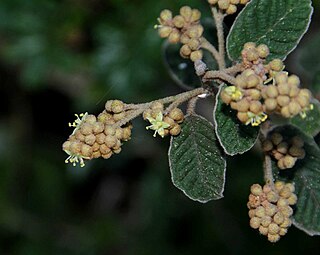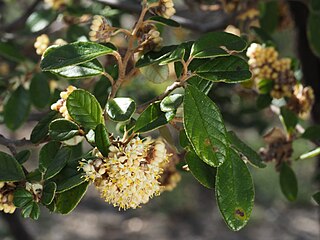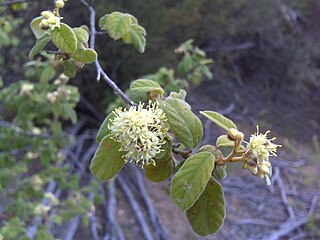
Grevillea lanigera, commonly known as woolly grevillea, is a species of flowering plant in the family Proteaceae and is endemic to south-eastern continental Australia. It is a spreading shrub with narrowly oblong to more or less linear leaves and clusters of pink to red, and cream-coloured flowers.

Correa alba, commonly known as white correa, is a species of shrub that is endemic to south-eastern Australia. It has egg-shaped to more or less circular leaves, erect white flowers arranged singly or in groups on short side branches, and green fruit.

Lasiopetalum ferrugineum, commonly known as rusty velvet-bush, is a species of flowering plant in the mallow family and is endemic to eastern Australia. Growing up to a metre tall, much of the plant is covered in rusty hairs. It is found in forest and heathland.

Pomaderris ferruginea, commonly known as rusty pomaderris, is a species of flowering plant in the family Rhamnaceae and is endemic to south-eastern continental Australia. It is a shrub with rusty-hairy stems, egg-shaped leaves, and clusters of cream-coloured, whitish or yellow flowers.

Pomaderris oraria, commonly known as Bassian dogwood, is a species of flowering plant in the family Rhamnaceae and is endemic to south-eastern Australia. It is a compact shrub with hairy branchlets, hairy, elliptic leaves and panicles of hairy, greenish to cream-coloured or crimson-tinged flowers.

Pomaderris paniculosa, commonly known as scurfy pomaderris, is a species of flowering plant in the family Rhamnaceae and is native to Australia and New Zealand. It is a shrub with hairy branchlets, round to elliptic or egg-shaped leaves with the narrower end towards the base and panicles of hairy, cream-coloured to greenish, sometimes crimson-tinged flowers.

Pomaderris mediora is a species of flowering plant in the family Rhamnaceae and is endemic to the central coast of New South Wales. It is a low-lying or erect shrub with hairy new growth, narrowly elliptic to lance-shaped leaves with the narrower end towards the base, and panicles of cream-coloured flowers.

Pomaderris andromedifolia is a species of flowering plant in the family Rhamnaceae and is endemic to south-eastern continental Australia. It is a shrub with lance-shaped to elliptic leaves and cream-coloured to yellow flowers.

Pomaderris betulina, commonly known as birch pomaderris, is a species of flowering plant in the family Rhamnaceae and is endemic to south-eastern continental Australia. It is a shrub with hairy young stems, lance-shaped to oblong or elliptic leaves, and yellowish flowers.
Pomaderris briagolensis is a species of flowering plant in the family Rhamnaceae and is endemic to Victoria, Australia. It is a shrub with hairy branchlets, egg-shaped or oblong leaves and panicles of white to rust-coloured flowers.

Pomaderris cotoneaster, commonly known as cotoneaster pomaderris, is a species of flowering plant in the family Rhamnaceae and is endemic to south-eastern continental Australia. It is an erect shrub with woolly-hairy stems, elliptic leaves, and leafy panicles of cream-coloured flowers.

Pomaderris discolor is a species of flowering plant in the family Rhamnaceae and is endemic to south-eastern continental Australia. It is a shrub with woolly-hairy stems, elliptic leaves, and clusters of pale yellowish flowers.

Pomaderris eriocephala is a species of flowering plant in the family Rhamnaceae and is endemic to south-eastern continental Australia. It is a spreading shrub with hairy stems, egg-shaped leaves, and clusters of cream-coloured flowers with white to rust-coloured hairs.

Pomaderris ledifolia, commonly known as Sydney pomaderris, is a species of flowering plant in the family Rhamnaceae and is endemic to south-eastern continental Australia. It is an erect, delicate shrub with hairy young stems, narrowly elliptic to lance-shaped leaves, and compact clusters of yellow flowers.

Pomaderris ligustrina, commonly known as privet pomaderris, is a species of flowering plant in the family Rhamnaceae and is endemic to south-eastern continental Australia. It is a shrub with hairy stems, lance-shaped to narrowly elliptic leaves, and loose clusters of cream-coloured or yellow flowers.

Pomaderris phylicifolia, commonly known as narrow-leaf pomaderris, is a species of flowering plant in the family Rhamnaceae and is to south-eastern Australia and New Zealand. It is a slender shrub with hairy stems, narrowly egg-shaped to linear leaves, and small clusters of cream-coloured to yellow flowers.
Pomaderris precaria is a species of flowering plant in the family Rhamnaceae and is endemic to New South Wales. It is a slender shrub with hairy new growth, elliptic to lance-shaped leaves with the narrower end towards the base, and panicles of cream-coloured flowers.

Pomaderris reperta, commonly known as Denman pomaderris, is a species of flowering plant in the family Rhamnaceae and is endemic to a restricted area of New South Wales. It is a shrub with densely rusty-hairy new growth, egg-shaped to elliptic leaves, and dense panicles of cream-coloured flowers.

Pomaderris subcapitata is a species of flowering plant in the family Rhamnaceae and is endemic to south-eastern continental Australia. It is a shrub with hairy stems, elliptic to egg-shaped leaves and dense clusters of cream-coloured or yellow flowers.

Pomaderris velutina, commonly known as velvety pomaderris or velvet pomaderris, is a species of flowering plant in the family Rhamnaceae and is endemic to south-eastern continental Australia. It is a slender shrub with rusty-hairy young stems, egg-shaped to oblong or more or less elliptic leaves, and loose panicles of pale yellow flowers.


















